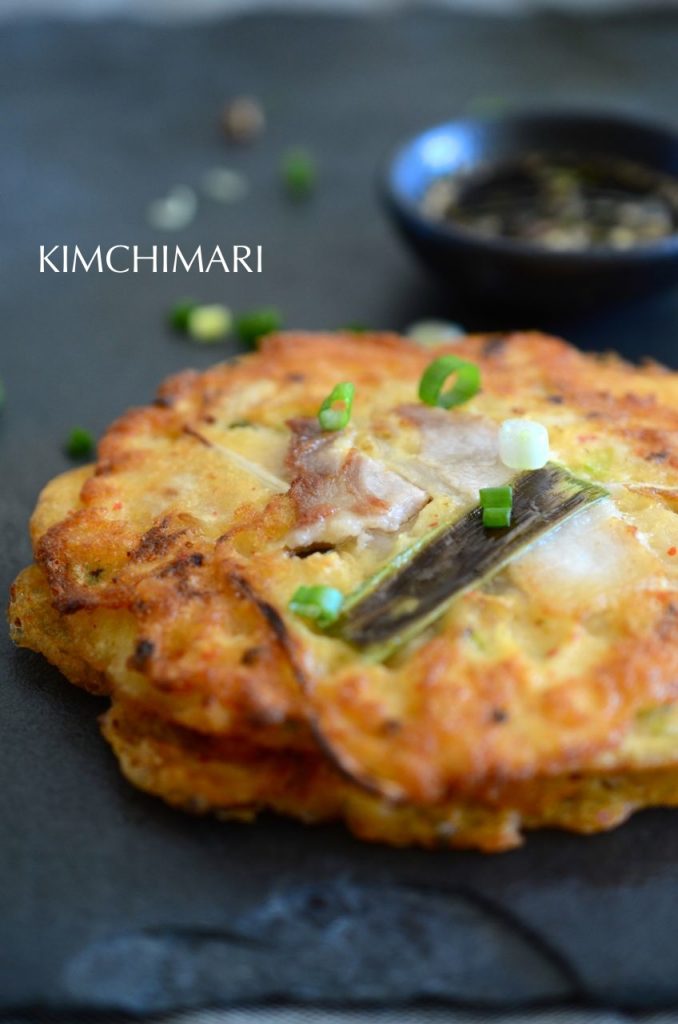
Bindaetteok!!! Oh how I have missed you..I am sorry that I am so late in writing a post about you. I always wanted to post about you from the time when I started my Korean food blog. Oh..Bindaetteok..You and I go way back.. to the days when I was a kid, sitting on the kitchen floor, making bindatteok all day with my sisters…. From morning till late afternoon, I helped my sisters cook bindaetteok until I was so tired of the smell that at the end of the day, I had no appetite for dinner – which was and still IS a rarity for me!! 🙂 We had to do this because we had to make a LOT of bindaetteok in preparation for big parties or for traditional Korean holidays like New Years and Chuseok (Korean harvest moon).
Especially for Korean New Year’s, we always had bindaetteok (빈대떡) or Nokdu Jeon(녹두전) and naengmyeon (Cold Noodles Soup) all ready to serve. We fed all guests that came to pay respects to my parents. Guests came morning, noon and night and Korean style hospitality meant we almost force fed them regardless of what time of day it was and no matter how strongly they said they already ate. Because, we all knew at least half of them were just saying that.. haha..
The great thing about bindaetteok is that you can make it ahead of time and just reheat it when you need to serve. Of course, I have to tell you that bindaetteok DOES taste best when it’s just freshly cooked so if you can make it right before you eat, that’s the best way to eat it.
Now, bindaetteok comes in many variations depending on the region but most Koreans will tell you that bindaetteok originates from Northern part of Korea. Scholars say there are different theories of its origin but the one that makes the most sense to me is that it comes from the times of Goguryeo (37 BC – 668 AD : One of the ancient Three Kingdoms of Korea, located in the northern and central parts of the Korean Peninsula and the southern and central parts of inner and outer Manchuria). Which then confirms the theory that the Northern style (이북식 yibukshik) bindaetteok is the original version and also the most delicious. 🙂 You may say that I’m biased and I’m fine with that. But hey, to me- our family’s bindaetteok recipe is the best.
Now the worst bindaetteok variations are the ones that mix rice flour or flour with mung beans. Because mung beans were lot more expensive than flour, restaurants added rice flour or flour to the batter. Bad versions also contain almost no kimchi. 🙁 When you do this, bindaetteok ends up being quite hard and dry. And sadly, very few restaurants get it right. So I usually don’t order bindaetteok at Korean restaurants (both in Korea or in US) unless the restaurant specializes in North Korean cuisine.
The recipe I provide below is a modernized, simplified recipe but still preserves the taste and texture of traditional authentic North Korean style bindaetteok. It is based on both my sister #2 and sister #3 recipes. Thank you sisters – as always. 😉
Servings: 12 pancakes Time: Prep 30 min + 1 hr Difficulty: Medium
Ingredients
- 2 C (12 oz/ 340 g) dried peeled split, mung beans (깐녹두 kkan nokdu/Lentille Verte) *kkan = peeled, nokdu = mung beans
- 2 1/4 C (540 ml) water
- 1 C ripe kimchi, sliced thin
- 1 handful of fresh bean sprouts (optionally, blanch and squeeze excess liquid)
- 3 slices of pork belly (bacon thickness) or samgyeopsal (삼겹살)
- 3 green onions
- pinch of salt
- splash of sesame oil
- lots of vegetable oil for frying
- Dipping Sauce
- 2 T soy sauce (진간장 jinkanjang)
- 1 T rice vinegar
- 1 T chopped green onions
- Soak peeled split mung beans in water according to package directions. The package I bought says 30 mins is enough. In the old days, you had to soak overnight so this is great! You may want to soak overnight just to be sure. This is the package I bought from my local market – try to buy bigger, unbroken mung beans.
dry split peeled mung beans package of peeled mung beans (깐녹두 Kkan nokdu) - Get 1 cup ripe Kimchi, remove excess seasonings/stuffing and also squeeze out excess liquid. Cut thinly.
- Chop 2 green onions and add to kimchi and season with a splash of sesame oil (about 1 tsp).
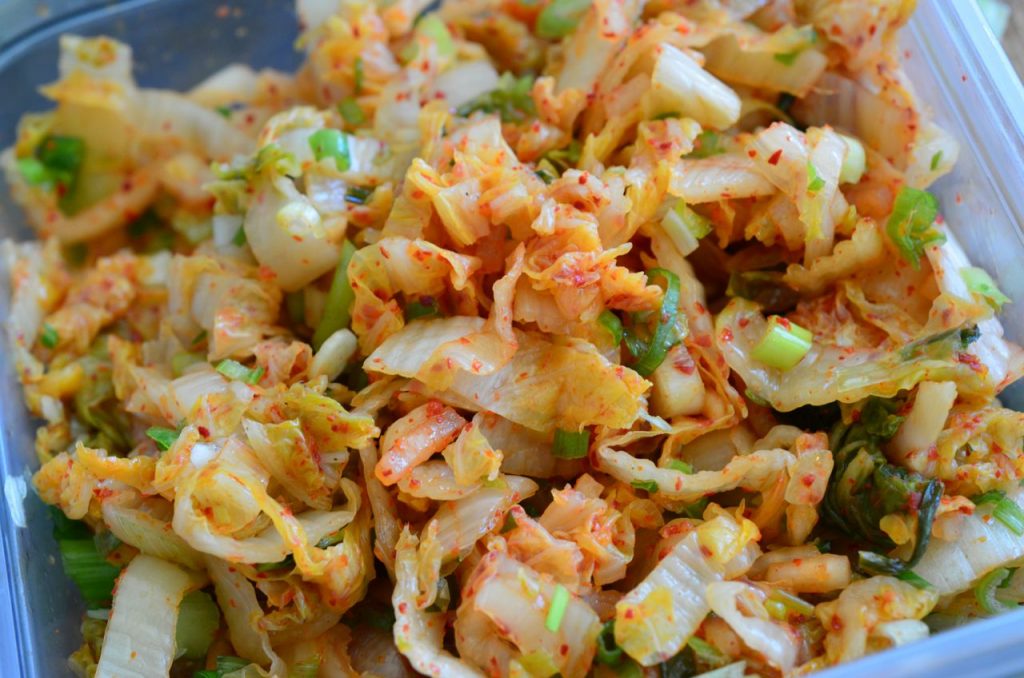
sliced kimchi and green onions mix for bindaetteok - Cut 1 green onion into 2 in (5 cm) long pieces. Splitting thicker white ends into halves.
- Rinse a handful of bean sprouts and drain. *Note, a fully traditional recipe uses blanched bean sprouts but my sister #3 uses it raw and I agree with her that raw sprouts add extra crunch. Also simpler to make.
- Cut pork belly slices into 1 in (2.5 cm) widths and set aside.
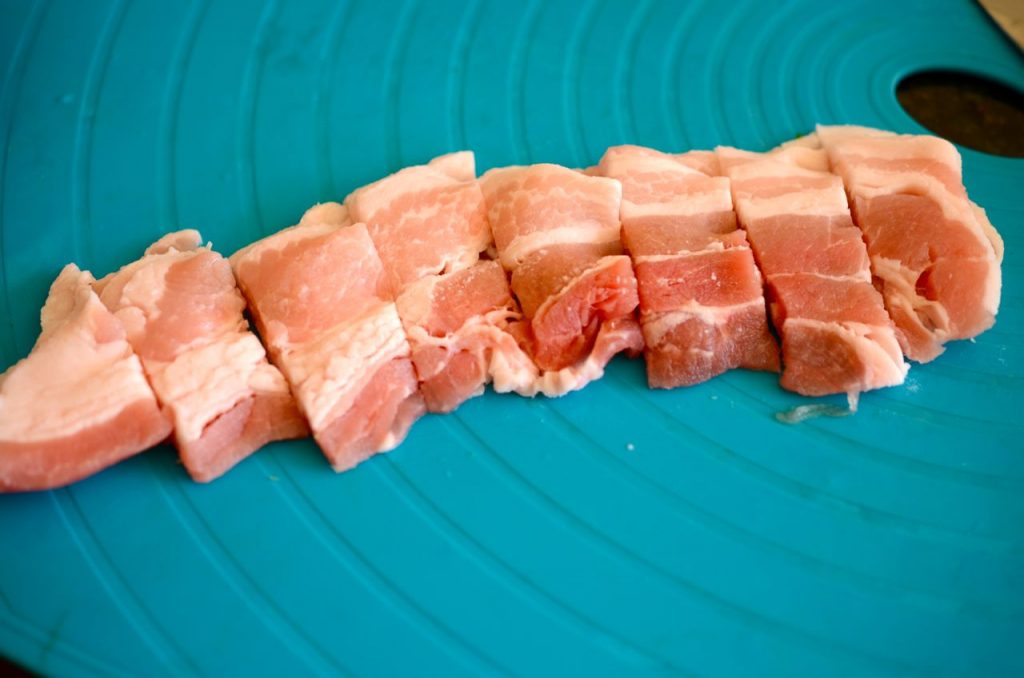
Pork belly slices for bindaetteok - In a blender, add soaked and drained mung beans and enough water to just cover the mung beans.
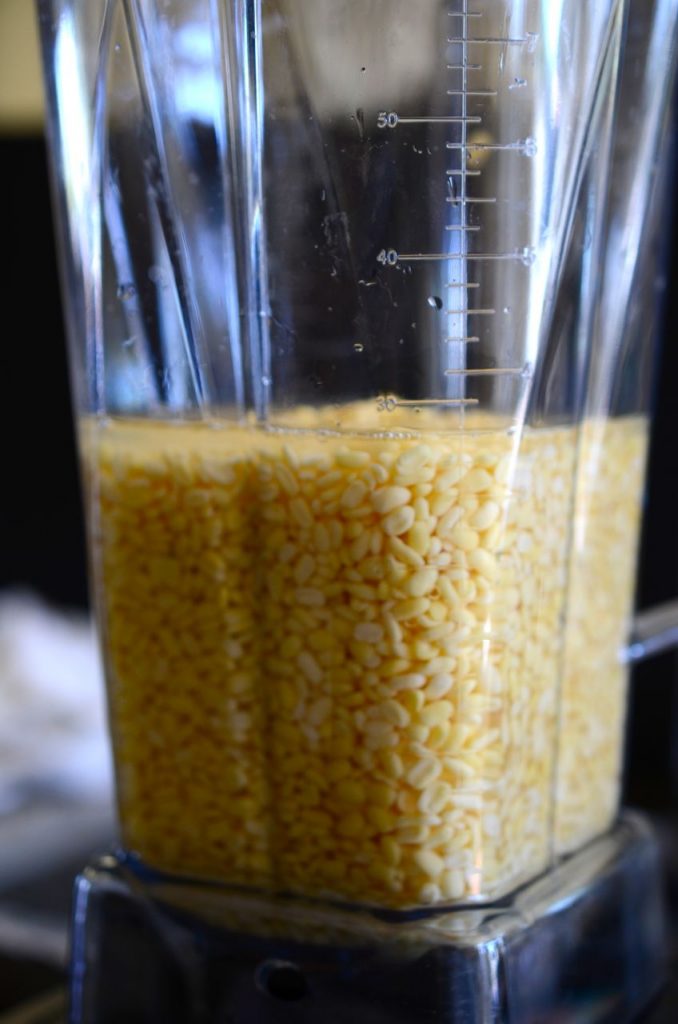
soaked mung bean in blender – note you will be adding more water later 2 cup dry beans make about 4 cup soaked mung beans. Add 1+ 1/2 cup water to 4 cup soaked mung beans and blend. Once blended, slowly ADD remaining 3/4 cup water till you have loose pancake batter consistency. The blend should look like this-
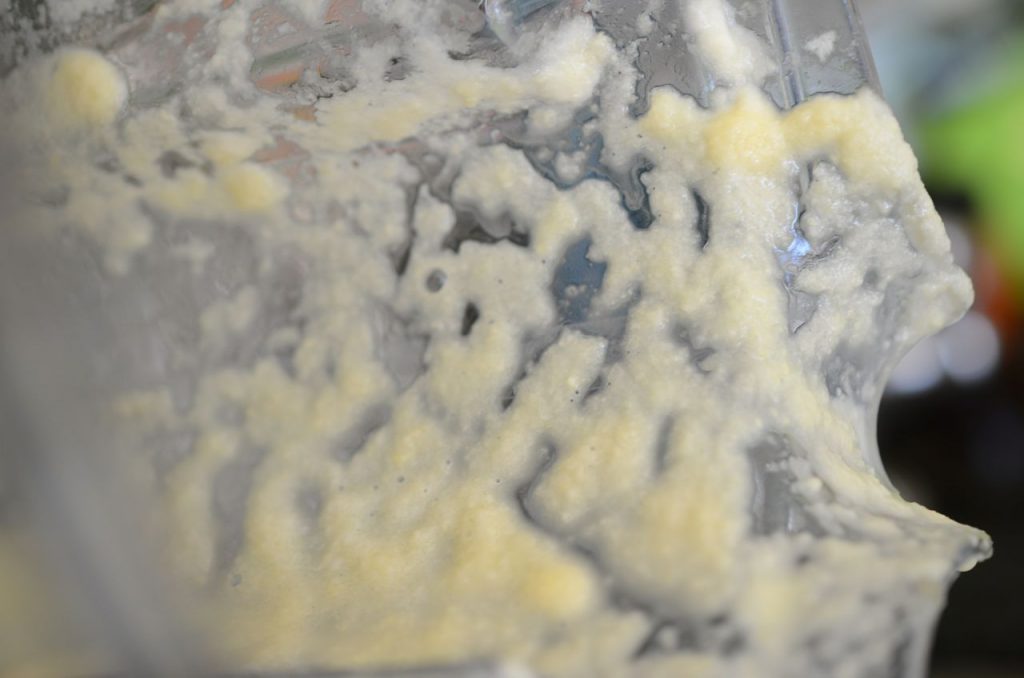
Blended mung bean consistency for bindaetteok - Arrange all ingredients for Bindaetteok (mung bean pancake) like so –
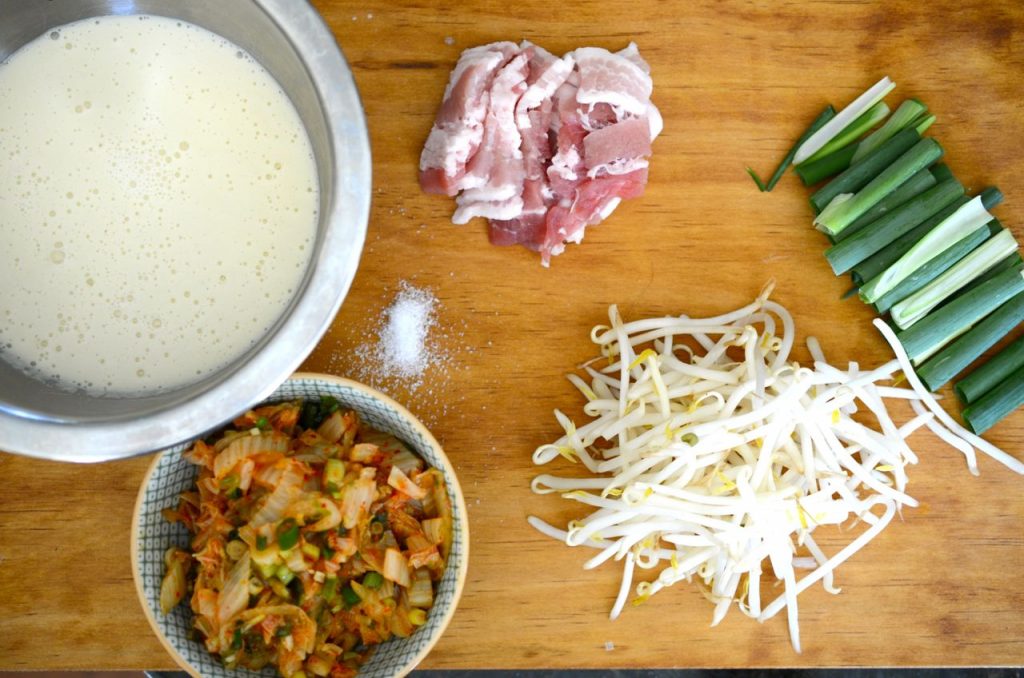
Ingredients for Bindaetteok (mung bean pancake) - Now to 1/2 of the mung bean batter, add 1/2 of the kimchi and mix.
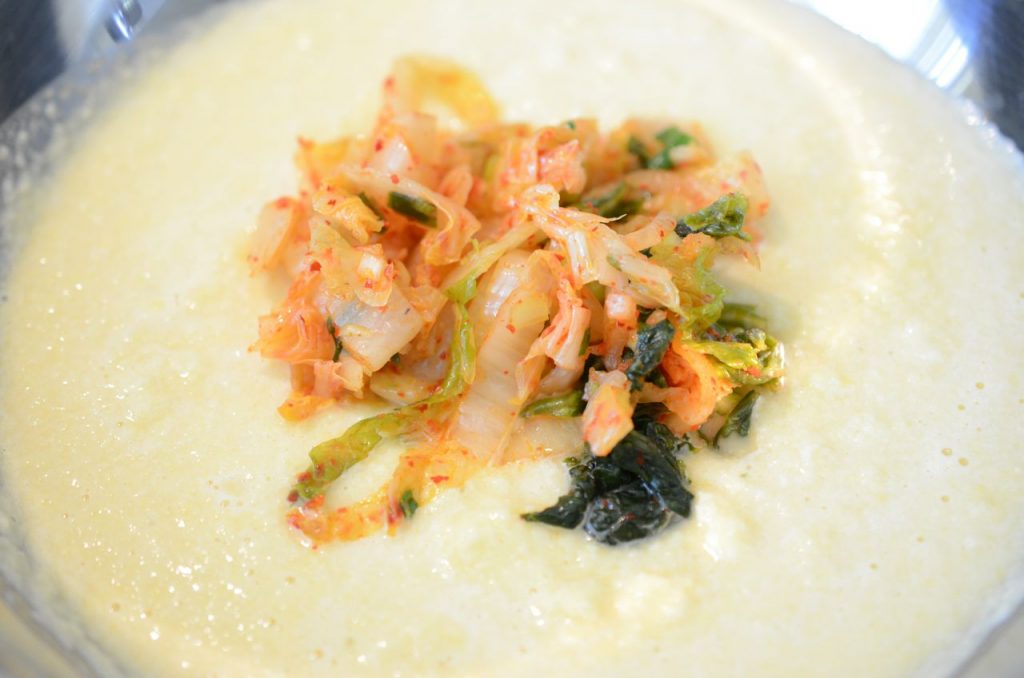
mungbeen batter with kimchi for bindaetteok 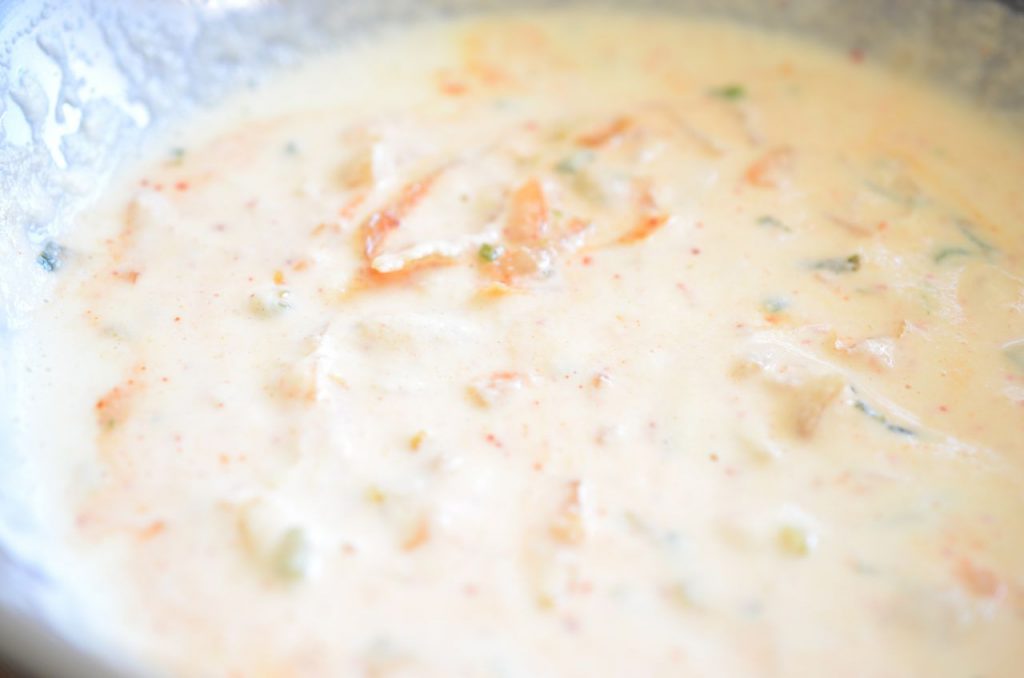
kimchi mixed in for bindaetteok batter This is how it should look once the kimchi is mixed in. If it looks much more red then you probably added too much kimchi or you have too much kimchi liquid.
The reason for dividing the batter is because mung bean mix will start to become watery once you add salt. So it’s better to mix a smaller amount, season and make the pancakes before they turn into mung bean water. And then start another batter.
- Add about 1/8 ~ 1/4 tsp salt to season batter.
- Heat 2 T oil on medium heat in a 10″ (25 cm) frying pan. When the pan is nice and hot, pour the mung bean batter in the pan. Making about three 4-5 in” (10 – 12 cm) size pancakes.
- While pancake is cooking, top with few bean sprouts, one to two pieces of pork belly and some green onion.
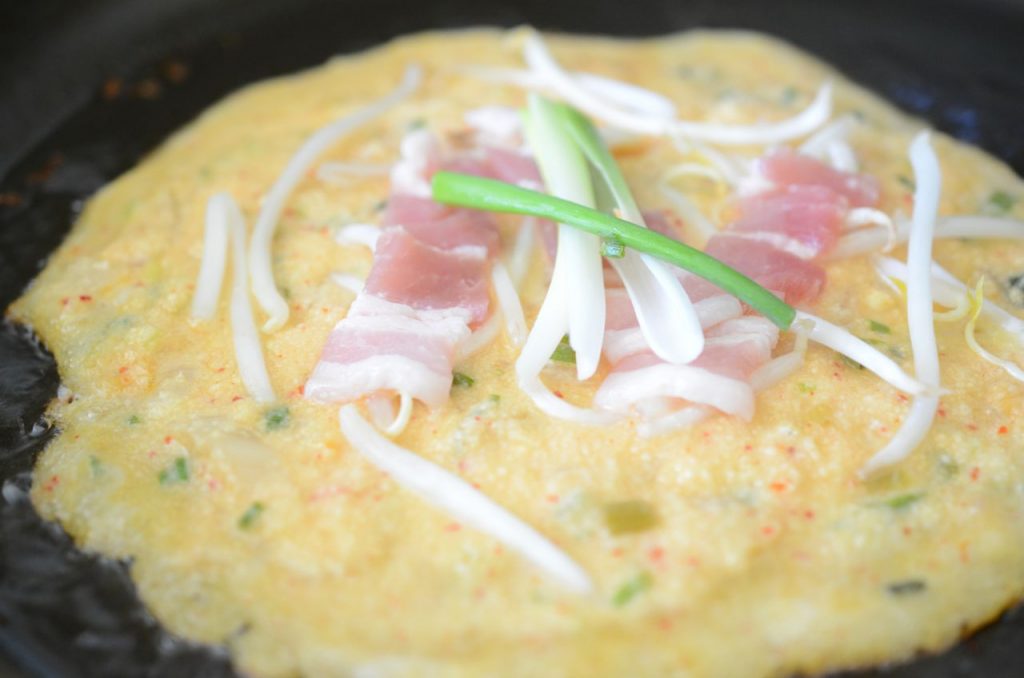
Bindaetteok cooking in pan – isn’t it beautiful?? 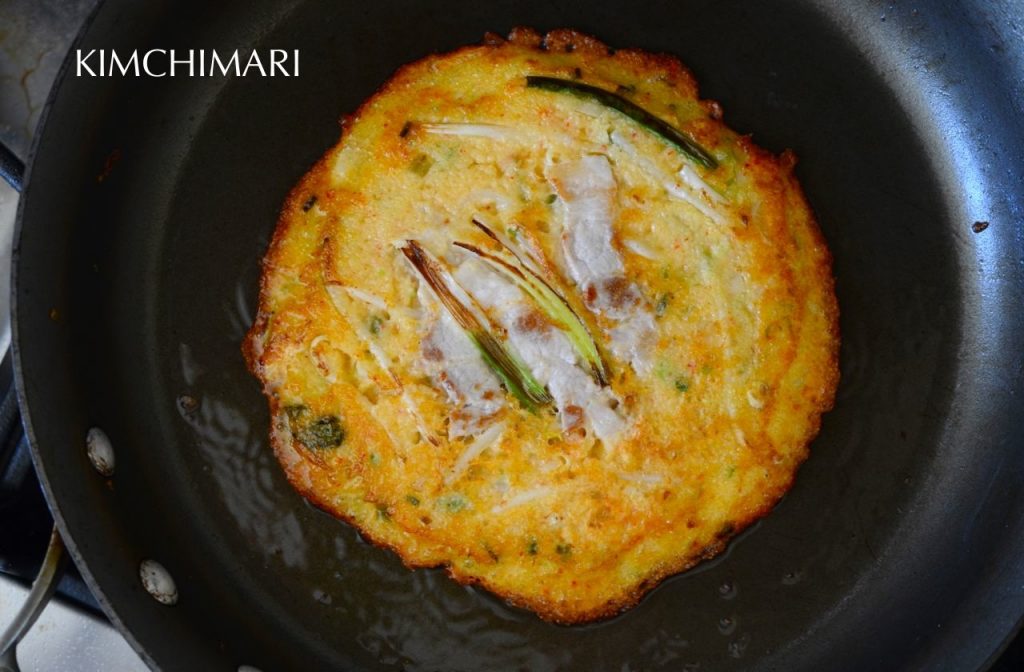
Korean mung bean pancake (bindaetteok) almost ready! - Once edges are brown, turn over and press with a spatula. Pancake is done when it is brown on both sides. Add more oil in between if the pan looks dry.
- Make the dipping sauce and serve! Best when it’s HOT off the pan.
And there you go!! You have a fabulous, gluten-free savory mung bean pancake or Bindaetteok (빈대떡) as we call it!
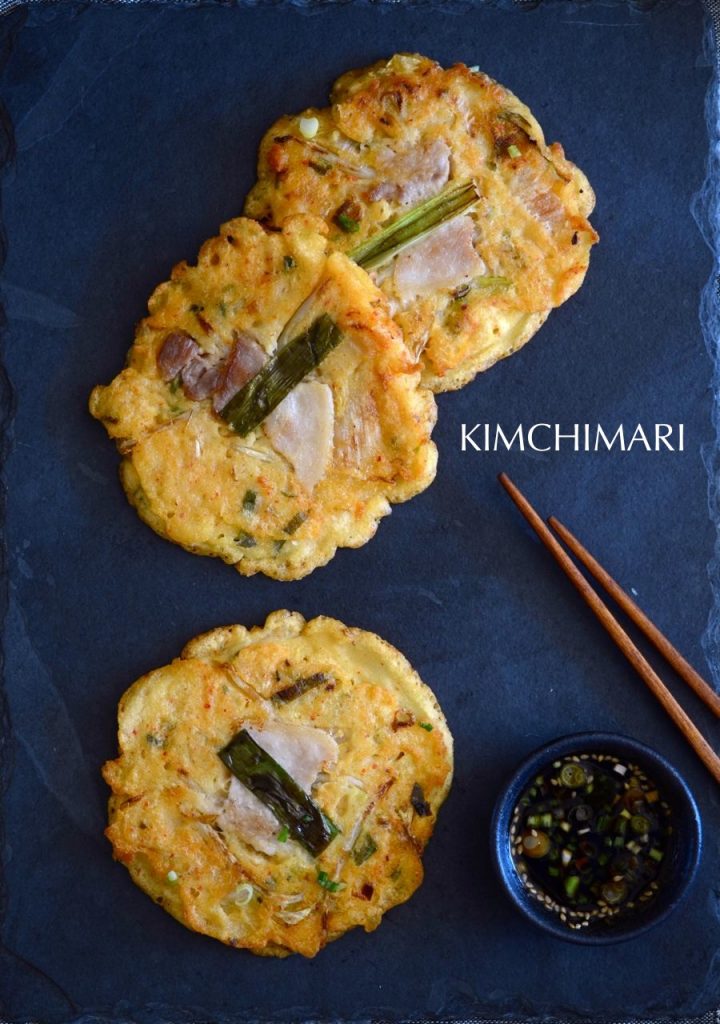
Bindaetteok - Mung Bean Pancake
Ingredients
- 2 C dried peeled split, mung beans (깐녹두 kkan nokdu/Lentille Verte) *kkan = peeled, nokdu = mung beans (12 oz/ 340 g)
- 2 1/4 C water
- 1 C ripe kimchi (sliced thin)
- 1 handful of fresh bean sprouts (optionally, blanch and squeeze excess liquid)
- 3 slices of pork belly (bacon thickness) or samgyeopsal (삼겹살)
- 3 green onions
- pinch of salt
- splash of sesame oil
- lots of vegetable oil for frying
Dipping Sauce
- 2 Tbsp soy sauce (진간장 jinkanjang)
- 1 Tbsp rice vinegar
- 1 Tbsp chopped green onions
Instructions
- Soak peeled split mung beans in water according to package directions. The package I bought says 30 mins is enough.
- Get 1 cup ripe Kimchi, remove excess seasonings/stuffing and also squeeze out excess liquid. Cut thinly.
- Chop 2 green onions and add to kimchi and season with a splash of sesame oil (about 1 tsp).
- Cut 1 green onion into 2 in (5 cm) long pieces. Splitting thicker white ends into halves.
- Rinse a handful of bean sprouts and drain..
- Cut pork belly slices into 1 in (2.5 cm) widths and set aside.
In a blender, add soaked and drained mung beans and enough water to just cover the mung beans.
- 2 cup dry beans make about 4 cup soaked mung beans. Add 1+ 1/2 cup water to 4 cup soaked mung beans and blend. Once blended, slowly ADD remaining 3/4 cup water till you have loose pancake batter consistency. The blend should look like this-
- To 1/2 of the mung bean batter, add 1/2 of the kimchi and mix.
- The reason for dividing the batter is because mung bean mix will start to become watery once you add salt. So it’s better to mix a smaller amount, season and make the pancakes before they turn into mung bean water. And then start another batch.
- Add about 1/8 ~ 1/4 tsp salt to season batter.
- Heat 2 T oil on medium heat in a 10″ (25 cm) frying pan. When the pan is nice and hot, pour the mung bean batter in the pan. Making about three 4-5 in” (10 – 12 cm) size pancakes.
- While pancake is cooking, top with few bean sprouts, one to two pieces of pork belly and some green onion.
- Once edges are brown, turn over and press with a spatula. Pancake is done when it is brown on both sides. Add more oil in between if the pan looks dry.
- Repeat with remaining batter.
- Make dipping sauce and serve! Best when it’s HOT off the pan.
Tips & Notes:
Nutrition Information:
Variations
- Carnivore – add chopped, seasoned ground pork to batter. It’s really good. sister #2’s recipe
- Vegetarian – omit pork, add more bean sprouts and you can have a great vegetarian, protein rich pancake
- Super Traditional – add rehydrated gosari (bracken fern). I don’t add this because it doesn’t add a lot of flavor. Just a little chewy texture. Also, blanch bean sprouts and squeeze excess liquid before chopping and adding to batter. This is good but more work.
- Spicy – add chopped green chili peppers or Jalapeno peppers for more kick
Tips
- Freeze leftover blended mung bean (BEFORE you add anything like kimchi) and other ingredients like pork separately. Then just defrost and cook later by adding kimchi and green onions, etc at time of cooking. Comes out just as good as the first time. – tip from sister #3
- Also freeze leftover cooked bindaetteok and reheat. Not as fresh tasting as freezing mung bean as tip #1 but pretty good too!
- Bindaetteok is soo good with Makgeoli (Korean rice wine) and/or Naengmyeon. A great party menu for Korean food lovers. I actually recently had a party with bindaetteok – will share the menu in my next post.
Till then, eat healthy and by happy!
take care,
JinJoo
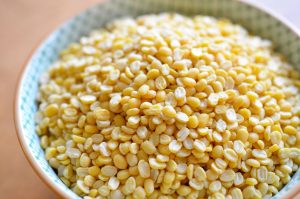
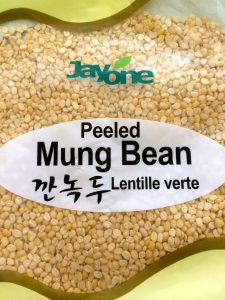
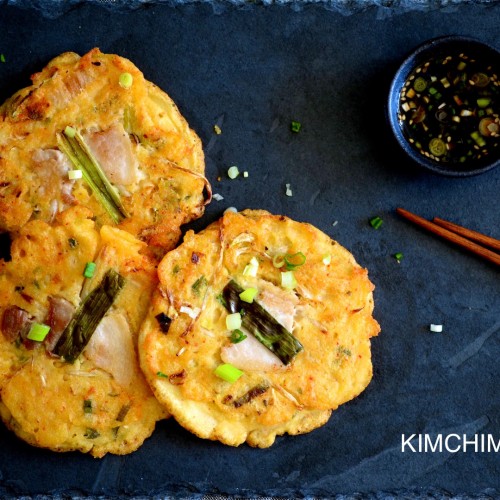
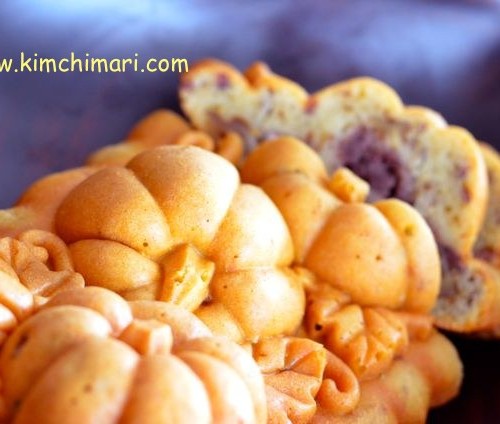
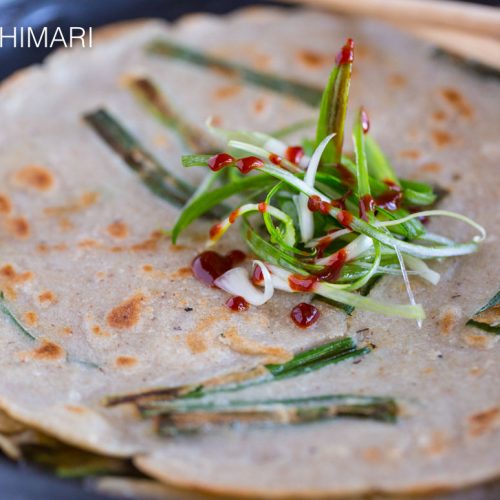
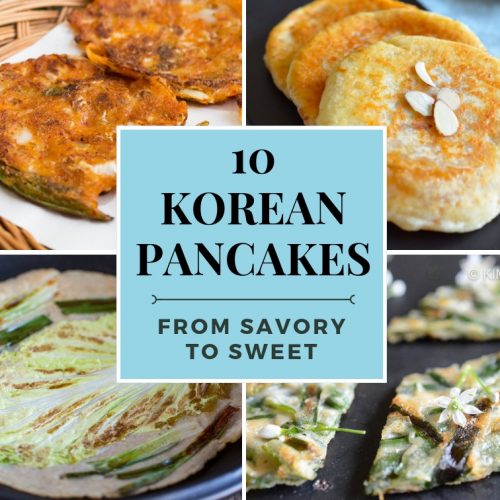
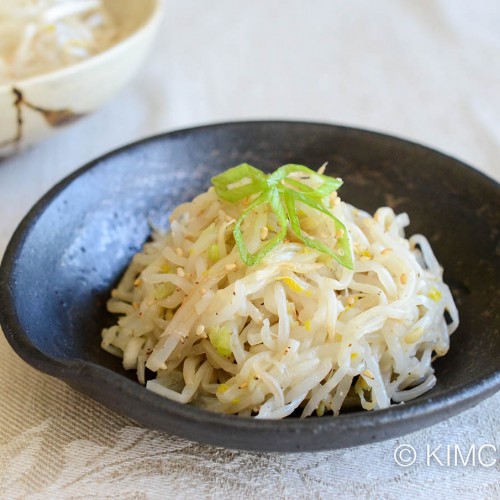
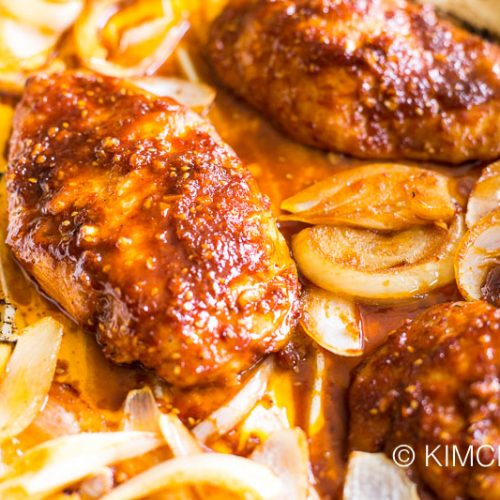
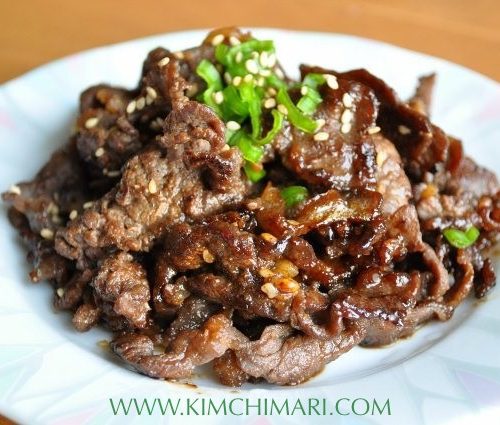
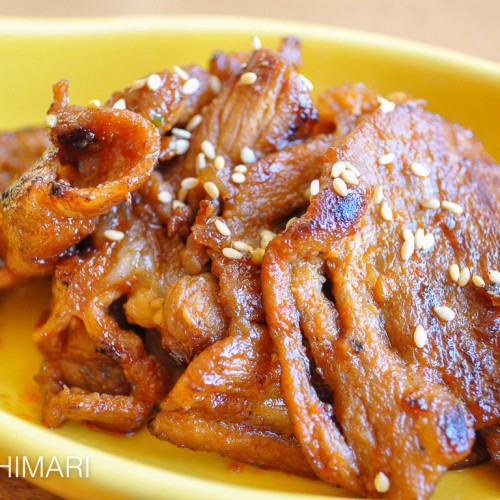
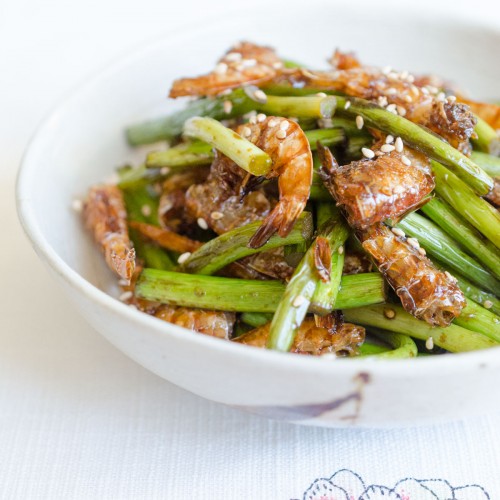
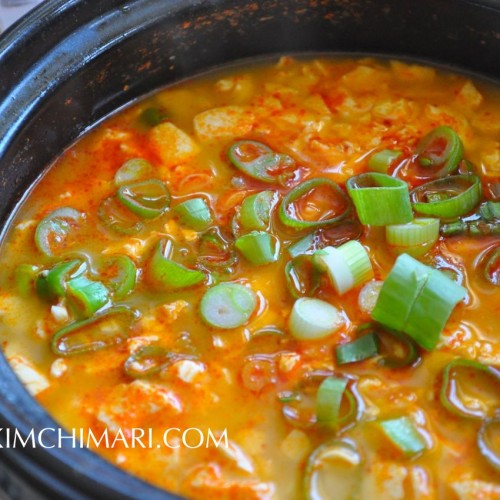
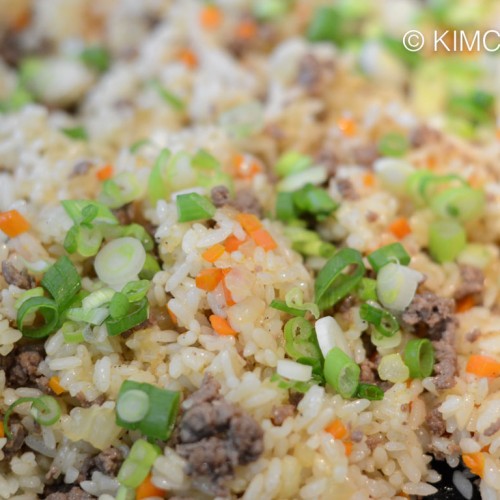
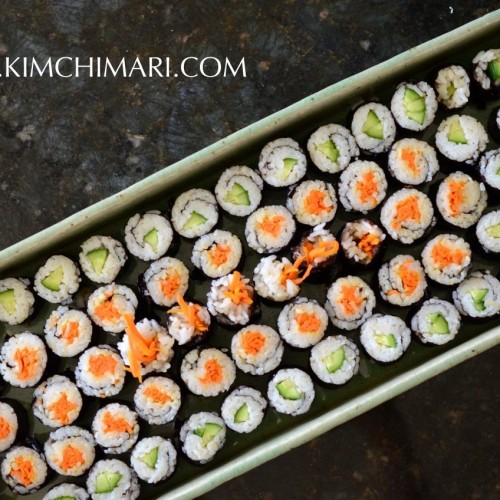
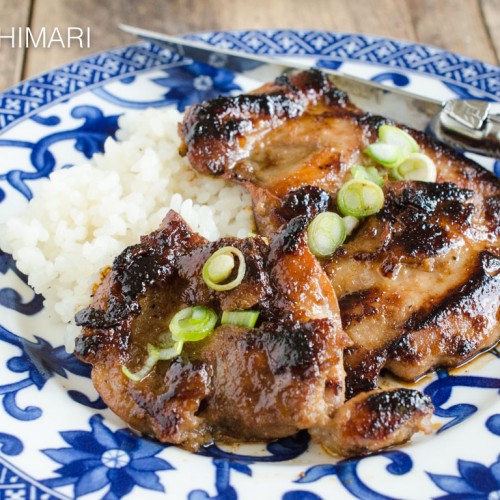
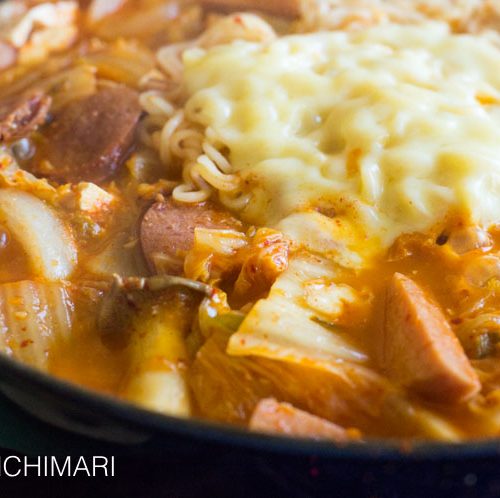
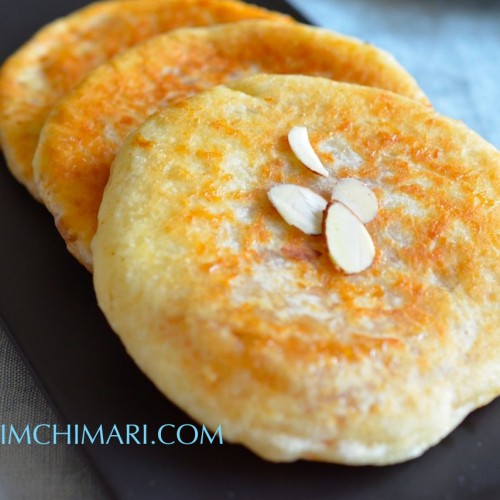






I wanted to thank you again for holding my hands through those pancakes. And to tell you that we ended up fermenting the leftover batter and making a version of S. Indian dosa pancakes. Also have been sending around links to your blog and noticed that a rather famous person ( 🙂 ) posted on Facebook so I think you are going to find you have a lot more followers . Best wishes to you and thanks also for following me on Instagram. Cheers, Annie
Hello Annie!! Oh, the pleasure was all mine..thank you thank you for passing my blog link around. You are just awesome!!! And wow, is that how you make Dosa?? Will you be putting up a recipe? Dosa is really one of my absolute favorite foods. I used to eat it all the time when I lived in India many eons ago… BTW, yes, I am suddenly getting a lot more traffic and also many more likes on my facebook page. Thank you again!
OK! Thank you for this! I actually have in my kitchen in Wales a lot I could substitute– bacon, some kimchi made with carrots and parsnips. I’m just wondering about the “peeled” mung beans and whether it’s ok to just use plain old mung beans. i think it’s going to have to be. Love your blog!
Hi! Great to hear from you! Well, bacon and Kimchi will just make any meal special. :)) So, you can try using plain, unpeeled mung beans because I mean, that’s how we did it in the old days. Whole mung beans need to be soaked longer (overnight) and then you don’t have to get rid of ALL the peels just enough to not make your batter green and probably too fibrous. After it is soaked, you can massage it with your hands a lot and then add more water and green peels should float to the top and then you can get rid of it by pouring out the excess water with peels in them. You can also just flash blend (just do quick blend in few short bursts) soaked mung beans in the blender, just enough to get the peels off and to break the mung beans.And then add water and wash peels away.
If you ended up not getting rid of the peels, I would LOVE to hear how it turned out. Cause I personally never did it that way myself. Thank you and Happy New Year!
Thank you for writing all that. Just seeing it. What I decided to do was to soak “urad dal” which looked the most like the legumes in your photograph. Also I couldn’t find bean sprouts so my plan, tomorrow, is to very thinly slice radishes. They’ll have to do 🙂 And thanks for following my blog!
Well, dal should work..bean sprouts is kind of optional – more for texture.Sure, radishes should work. You can also just add lot more green onions instead. 🙂
I’m so grateful to you! These are SO good, even with all my substitutions!
komapso,
viewing pics and reading recipe…brings back mani mani good memories of my Yobo. Will try recipe once house is in order…thank you, R/Ernie
I am glad that my recipe and pics make you think about the good times with your yeobo. 🙂 I would love to hear how you like my recipes – thanks for letting me know! Wish you all the best,
Hello and thank you? As usual a lovely blend of must try recipe, personal and historic anecdotes and gentle language tutoring. I love it! Thank you.
Oh what a wonderful compliment. You have described exactly what I try to do for each post, so that makes me very happy. To actually hear that I’m somewhat achieving my goal for my blog. Thank you, I am grateful for your words. 🙂
You have a wonderful blog! I really enjoyed browsing through your posts. And I also nominated you for ‘Versatile Blogger Award’. Go find out more about it here – http://spicycandiedlife.com/versatile-blogger-award/
Thank you Jin for the nomination!! I am so happy!! I usually don’t get to read many other blogs – always so busy but this will make me think and look around. I will write a post soon~
You’re welcome! Same here, being nominated made me look around more and learn about other bloggers more. Hope you enjoy 😉